A Wide Spectrum of Pest Management Options
Our Sunflower Pest Solutions resource offers insight on the pests that threaten
yield and the products that can help you meet the quality and yield requirements
of your sunflower contract. From pest descriptions to control recommendations, you’ll
find the information you need to build a management plan that maximizes your profit
potential.
Select a pest below to learn more.
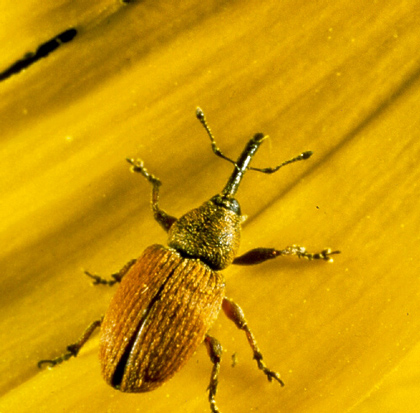
Red sunflower seed weevil. Source: The University of Minnesota.
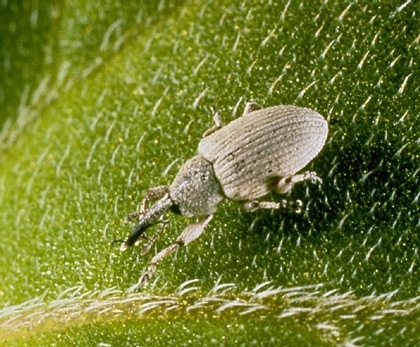
Gray sunflower seed weevil. Source: The University of Minnesota.
Description
Weevils are the most common insect pest in sunflowers. The red and gray seed weevils,
identifiable by their elongated “snouts,” cause little damage to young sunflowers
when feeding on their developing bracts. However, both the red and gray seed weevil
hatch and feed internally on sunflower seeds, which can cause significant yield
loss. At ⅛-inch in length, the red seed weevil is slightly smaller than the ¼-inch
long gray seed weevil. Typically, the gray seed weevil, more abundant in the South,
will consume more of the sunflower seed than the red seed weevil, which is more
common from the Appalachian Mountains to the Pacific Northwest. For the oleic market,
both red and gray seed weevils ultimately reduce yield and test weight. In the confection
market, damaged seeds are sold at a discounted price if over a predetermined damage
threshold.
Symptoms
- Gray sunflower weevil
- Enlarged seeds that lack a kernel
- Empty kernels, as it can completely consume seeds
- Reduced seed weight and oil content
- Red sunflower weevil
- Partially empty kernels, as it can consume about ⅓ of the kernel
- Reduced seed weight and oil content
Monitoring and Management
- Gray sunflower weevil
- Scout field borders for gray sunflower weevil activity
- Tillage, like moldboard plowing and disking in particular, reduces the emergence
of overwintering adults
- Apply insecticides like
Besiege,
Karate with Zeon Technology or
Warrior II with Zeon Technology at the R2 stage
- Red sunflower weevil
- Moldboard plowing in the fall or spring can reduce adult emergence
- Plant early so sunflowers mature earlier than ideal feeding windows
- Scouting should begin in the R3 and R4 bud stages and continue through R5, as seeds
can host eggs
- Scout field borders for red sunflower weevil activity
- Apply insecticides like
Besiege,
Karate with Zeon Technology or
Warrior II with Zeon Technology
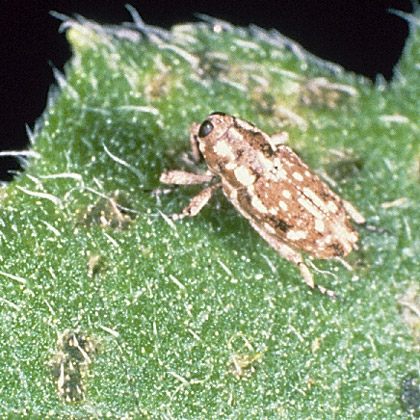
Sunflower stem weevil. Source: University of Minnesota.
Description
Feeding on sunflower plant stems, the sunflower stem weevil is ⅛- to ¼-inch long,
gray-brown with white spots and black antennae, snout and eyes. It usually emergences
in May and June and is most common in the High Plains. Adult sunflower stem weevils
feed on foliage, which is usually not severe enough to require insecticide applications.
However, larvae feed on the interior of the stem as they grow, which ultimately
reduces yield through lodging and poor plant development. Sunflower seed weevils
also vector the damaging Phoma disease, which can lead to lodging and early
ripening, as well as cause more intensive damage when crops are under drought stress.
Symptoms
- Foliar damage from adult weevil feeding, which is usually minor
- Reduced stalk strength, which can lead to preharvest lodging
- Presence of Phoma black rot symptoms
Monitoring and Management
- Plant after the first week of June to avoid infestation risk
- Reduce plant population to increase plant stalk thickness and prevent lodging
- Double-crop sunflowers to avoid infestation risk
- Scout through mid-July for sunflower stem weevil insects and damage
- Apply insecticides like
Besiege,
Karate with Zeon Technology or
Warrior II with Zeon Technology
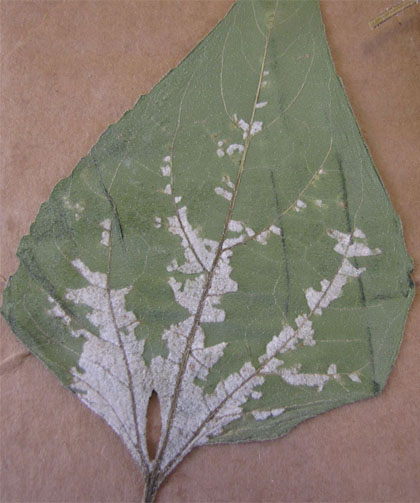
Signs of downy mildew sporulation along veins on lower leaf surface of sunflower.
Source: Purdue University.
Description
A result of the soilborne fungal pathogen Plasmopara halstedii, downy mildew
can attack plants in two waves. The primary systemic infection is more problematic,
while secondary infections caused by windblown spores from infected plants are usually
not severe enough to significantly affect yield or quality. Systemic infections
occur as the pathogen invades sunflower seedling roots, which often kills plants
and causes significant stand reduction. When the disease is distributed sporadically
across fields, unaffected plants often compensate to minimize yield loss. However,
widespread infections can cause significant yield loss as healthy plants are unable
to compensate. The pathogen thrives in cool, water-saturated environments and can
stay in the soil for up to 10 years, so preventive measures are critical in minimizing
the threat of infection.
Symptoms
- Systemic infection
- Wilted, severely dwarfed or dead sunflower seedlings
- Thick and yellow (chlorosis) cotyledons along foliage veins
- White cotton-like material on the underside of infected leaves
- Moderately stunted plants at the 6- to 8-leaf stage with foliar symptoms appearing
on the upper leaves only in delayed infections
- Secondary infection
- Small, “local” lesions appear on foliage
- White, cotton-like material on the underside of local lesions
Monitoring and Management
- Control weeds to prevent the pathogen from surviving on other hosts
- Treat sunflower seeds with
CruiserMaxx Sunflower plus Bion® seed treatment combination of
separately registered products
- Apply
Quadris fungicide for foliar control
Sclerotinia
Sclerotinia sclerotiorum
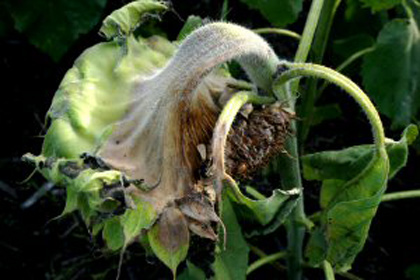
Sclerotinia head rot. Source: Province of Manitoba.
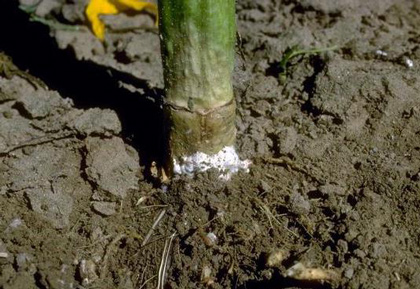
Sclerotinia stalk rot. Source: University of Wisconsin Cooperative Extension.
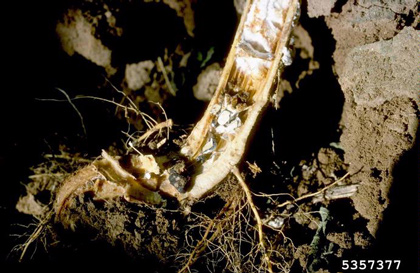
Sclerotinia Basal stalk rot. Source: Forestry Images via Colorado State University.
Description
Sometimes called white mold, Sclerotinia can be one of the most devastating
diseases for sunflowers under weather conditions conducive to disease development.
The disease advances and thrives in wet, cloudy conditions and can stay in the soil
for several years. Wet soil for 10 to 14 days can allow Sclerotinia to
produce thick-walled sclerotia, which germinate and produce tiny mushroom-like fungal
growth called apothecia. Spores from apothecia are then carried via wind to infect
sunflower plants by activating with water on dead or senescing plant tissue. The
disease is absorbed by sunflower roots, immediately killing or severely wilting
plants. Sclerotinia can result in three different diseases, depending on
the pathogen: basal stalk rot and wilt, mid-stalk rot and head rot.
Symptoms
- Basal stalk rot and wilt:
- Sudden death or wilting plants without any foliar lesions
- Light-brown, water-soaked lesion at the soil line
- White, cotton-like material forms on the lesions at the soil line under prolonged
wet environments
- Internal shredding and bleaching of stem
- Hollowed-out, rotten stalks filled with black sclerotia no larger than 2 mm, which
are small energy reserves capable of dormancy under extreme conditions to keep fungi
alive over prolonged periods
- Mid-stalk rot:
- Infected leaves that proceed down the petioles to the stalk
- Light-brown, water-soaked lesions on stalk
- Breakage of stem at the point of infection
- Head rot:
- Dark, water-soaked spots on the back side of the flower head
- White, cotton-like materials covering portions of developing seeds
- Irregularly shaped Sclerotinia fill the head and the interior of the head
rots
- Head tissue takes on net-like webbed appearance
- Complete disintegration of the sunflower plant head
Monitoring and Management
- Using fall shallow cultivation in reduced tillage operations may expose Sclerotia
to cold winters and help reduce activity
- Practicing deep cultivation buries Sclerotinia and increases the chance
for survival and root infections, but it will reduce incidence at the soil level
- Employ three- to five-year rotations with non-host monocots like wheat, corn or
barley to reduce Sclerotinia in the soil
- Plant resistant hybrids when possible
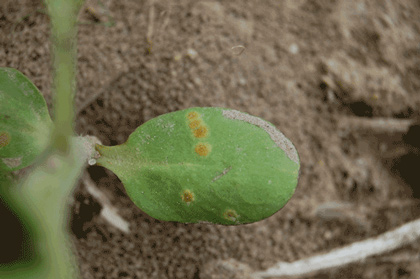
Sunflower rust pycnia. Source: North Dakota State University via Bob Harveson, University of Nebraska.
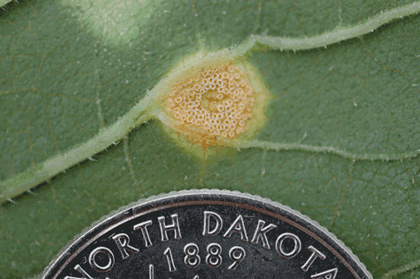
Sunflower rust aecia. Source: Sam Markell, North Dakota State University.
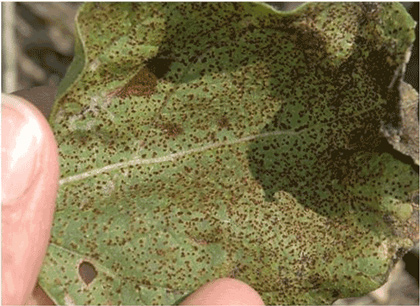
Sunflower rust uredinia. Source: Sam Markell, North Dakota State University.
Description
Generally affecting more sunflowers in the confection market than the oil market,
sunflower rust is a soilborne fungal disease resulting from the Puccinia helianthi
pathogen. Sunflower rust favors hot, humid conditions. At least two to three hours
of leaf wetness are required for sunflower rust to infect plants. Pathogen spores
germinate between 55° and 85° F – as temperatures increase, so does the rate of
new infections, which can occur every eight to 14 days. While moisture content then
becomes a non-issue for infected sunflower crops, high temperatures are conducive
to the development of the disease. Sunflower rust has a significantly greater impact
on sunflowers before bloom, causing up to 40 percent yield loss, while sunflowers
infected after bloom experience up to 10 percent yield loss.
Symptoms (in chronological order):
- Small yellow-orange spots called pycia on the top side of cotyledons or lower leaves
- Small aecial cups on the underside of pycia, which appear in small, yellow-white
circular clusters
- Tiny cinnamon-brown dots called uredinia pustules appear on the upper and underside
of infected leaves within two weeks of aecial cups
- Uredinia pustules can be rubbed off with minimal effort and leaves a streaking trail
when touched
- Before winter, uredinia become tiny black dots called telia, which do not rub off
Control
- Manage volunteer and wild sunflowers to break the disease cycle
- Do not plant sunflowers in the same field two years in a row
- Make preventive and curative applications of
Quadris fungicide
Kochia
Kochia scoparia
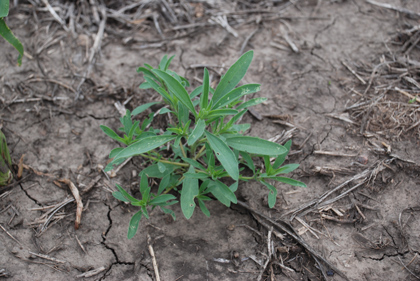
Kochia at the 3- to 5-leaf stage. Source: University of Minnesota Extension.
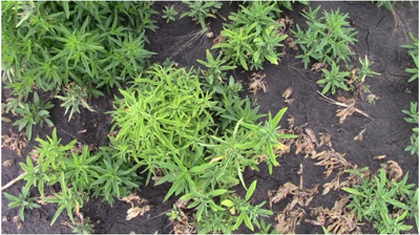
Kochia. Source: North Dakota State University.
Description
Kochia is a serious weed problem in many sunflower-growing regions, particularly
in instances where it has developed resistance to glyphosate, auxin and ALS-inhibitor
herbicides. Hardy in cold weather when it emerges in early spring, kochia can also
thrive in hot weather and is able to germinate in temperatures exceeding 100° F.
When the bush-like weed isn’t competing with crops or other plants, it can grow
up to seven feet tall and develop extensive root systems. Kochia fertilizes itself,
and each plant can produce up to 15,000 seeds. When mature, an abscission layer
develops near the base of the soil, which can cause the plant to break off in the
wind and spread seed by blowing across a field – it is known as a tumbleweed.
Monitoring and Management
- Apply glyphosate herbicide between preplant and preemergence
- Seven to 10 days after applying a glyphosate herbicide, apply
Gramoxone® SL 2.0 burndown herbicide
- Plant sunflowers in a weed-free seedbed
- Apply an early-season residual herbicide like
Sequence®
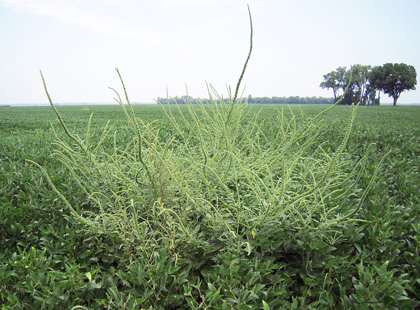
Palmer amaranth. Source: Purdue University.
Description
Palmer amaranth has become one of the most common weeds infesting sunflower fields
across the High Plains. Part of the pigweed family, Palmer amaranth seedlings emerge
from the red-brown seeds in May through July. Palmer amaranth plants can photosynthesize
more efficiently than most crops and are able to develop rapidly even in hot, dry
conditions. Mature plants are dense and compact, with red-purple petioles longer
than its smooth, glossy leaves. Palmer amaranth is an increasingly problematic weed
for sunflower growers, as it has shown resistance to glyphosate and ALS-inhibitor
herbicides over the past decade. According to Kansas State University, even moderate
Palmer amaranth infestations can result in more than 50 percent yield reduction.
Monitoring and Management
- Scout for Palmer amaranth early and take note of its reaction to herbicides with
different active ingredients
- Apply a pre-plant burndown using glyphosate mixed with 2,4-D to eliminate glyphosate-resistant
plants
- Seven to 10 days after applying a glyphosate herbicide, apply
Gramoxone SL 2.0 burndown herbicide
- Apply an early-season residual herbicide like
Dual Magnum®
- Work with your Syngenta representative to identify and develop management solutions
for glyphosate-tolerant populations
Photos are either the property of Syngenta or used under agreement.
©2016 Syngenta. Important: Always read and follow label instructions. Some products
may not be registered for sale or use in all states or counties. Please check with
your local extension service to ensure registration status. Besiege, Gramoxone SL
2.0, Karate with Zeon Technology and Warrior II with Zeon Technology are Restricted
Use Pesticides. Besiege, Karate with Zeon Technology and Warrior II
with Zeon Technology are highly toxic to bees exposed to direct treatment on blooming
crops and weeds. Do not apply these products or allow them to drift onto blooming
plants while bees are foraging adjacent to the treatment area.
CruiserMaxx Sunflower is an on-seed application of separately registered products
containing Cruiser 5FS insecticide and three fungicides: Apron XL, Maxim 4FS and
Dynasty.
Apron XL®, Besiege®, Cruiser®, CruiserMaxx®,
Dual Magnum®, Dynasty®, Gramoxone®,
Karate with Zeon Technology®, Maxim®, Quadris®,
Sequence®, Warrior II with Zeon Technology® and the
Syngenta logo are trademarks of a Syngenta Group Company. Bion® is
a trademark of Merck KGaA.